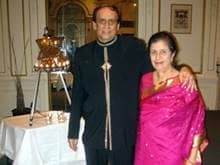
By Lavina Melwani
India has been a home and haven for generations of Jews whose ancestors fled from persecution centuries ago. At its peak there were about 37,000 Jews living in India. When Rabbi Gavriel Holtzberg and his wife Rivka were murdered in the terror attack in Mumbai last year, this horror story became the public face of Judaism in India. The truth is that, apart from this random attack by foreign terrorists, India has been an oasis of calm and freedom for Jews--giving them citizenship and complete freedom to practice their faith, build many synagogues, and celebrate their traditional festivals with an added Indian zest.
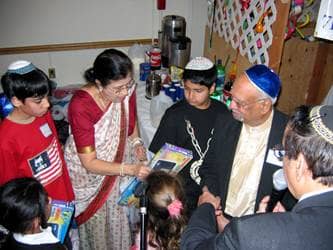
India's Jews Consist of Four Groups
The Jews of India consist of four groups: the Cochin Jews or Cochinis, the Baghdadis, the Bene Israel, and the B'nei Menashe.The Cochin Jews settled in Cranganore and around Malabar in the South and lived there for centuries. They never numbered more than 2,500, and many have now left for Israel. In fact, today there are not more than 16 of them left in Cochin, mostly elderly men and women.
The Baghdadis consists of Jews from West Asia, mainly from Iraq and Syria, who came in the 19th century as traders and refugees. They settled in Bombay, Calcutta, and Pune and spoke Arabic or Persian and English. At one time, there were about 5,000 of them, but today there number less than 200, most of them having emigrated to the U.K., Australia, and Canada.
The B'nei Menashe were a new group which came into being in 1964, and today there are more than 5,000 living in North East India.
The last community is the Bene Israel which is the predominant Jewish presence in India today.
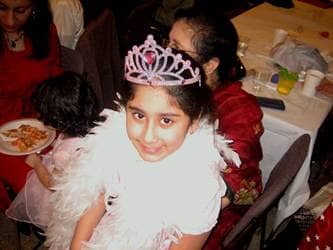
The Bene Israel
It is believed that the Bene Israel community descended from the Jews who fled in 175 B.C.E. from the Syrian-Greek ruler Antiochus Epiphanes. They were shipwrecked at Navgaon on the Konkan Coast, and the survivors started a new life there. Over the years, their families spread to the surrounding villages.David Rahabi, a Cochini Jew, is credited with the revival of Judaism among the Bene Israel, teaching them Hebrew and the rituals of Judaism. They set up their first synagogue in 1796 and expanded to 29 synagogues around Bombay and the neighboring villages. Their population grew to 30,000 around the time of Indian independence.
When Israel became a state in 1948, many of the Bene Israel. influenced by religious Zionism, started emigrating to Israel. By 1964 more than half the population had left. By the early 1970's, there were fewer than 10,000. Today only about 5,000 Bene Israel Jews remain in India, most in Bombay and Thane.
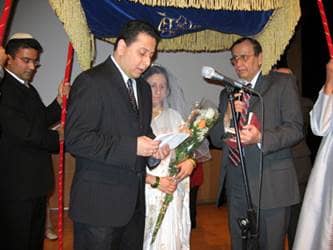
Indian-Jewish Wedding Customs
Indian-Jewish wedding traditions are especially joyous and festive. Recently Lael and Regina Daniel (Lael is the son of Romiel Daniel, the religious leader of the Indian-Jewish community in New York) re-enacted their wedding ceremony so guests could catch a glimpse of the special customs. The bride wears a white sari with intricate gold embroidery. She and the groom enter the synagogue in ways special to the Bene Israel community. The wedding feast is replete with Indian spices and coconut.The Bene Israel hold Elijah the Prophet in high regard, so when they celebrate a marriage, buy a house, or start any new venture, they invoke the protection of God through Elijah, and these prayers are said before any other prayers.
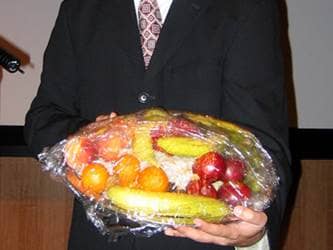
Indian-Jewish Cooking
During festivals and celebrations, the basic traditional dishes are the same as in other Jewish communities, but the methods of preparation vary. (Malida, above, is the Persian word for confection, and is made from parched rice mixed with sweetened coconut and fruit.) Puris, or sweet puffs, are an Indian delicacy made between Rosh Hashanah and Yom Kippur, and again at Rosh Hashanah. A special halva of wheat flour with a filling of sweet semolina, dried fruits, and sugar is served.Indian spice and sweets influence the cooking, and Indian curries are a regular at Indian-Jewish homes. Usually the fish for Rosh Hashanah is stuffed with spices like green coriander, ginger, garlic chilies, coconut, and lime.
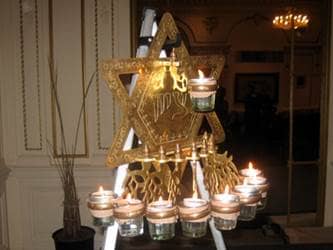
Celebrating Hanukkah, Indian Style
Here, the Star of David is made into a Hanukkiya (instrument to hold the oil lamps), a typical sign of the Indian celebration. Whereas other cultures use Hanukkah candles to light the lamps, Indian Jews still use oil. Indian Jews have incorporated many cultural traditions of India into their Jewish traditions and are proud of them.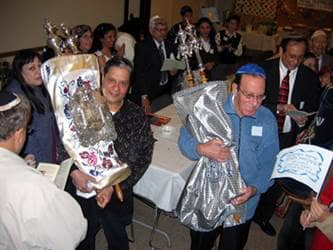
Celebrating Simchat Torah
Ten days after Yom Kippur is the celebration of Simchat Torah--in which the congregation dances joyously, holding the Sifrei Torahs. The Sifrei Torahs contain the five books of Moses, handwritten scrolls that are very precious. It takes more than a year for one scroll to be completed.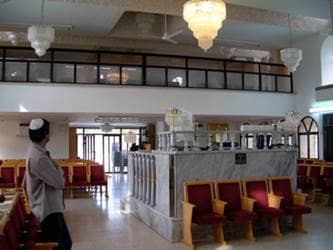
Indian Jews in Israel
More than 70,000 Bene Israel Jews from India now live in Israel but maintain their links with India. Since 1992, trade between Israel and India has been good, and India is now Israel's second largest trading partner in Asia, after Japan. Full-fledged consulates and embassies have been established between the two countries. The Indian-Jewish community has prospered in israel and has built 55 Orthodox synagogues there in keeping with the Bene Israel tradition.Indian Jews are in many businesses in Israel, including Indian restaurants – so now you can always find kosher Indian treats there! In fact, Indian food has caught on so much that non-Jewish Indian entrepreneurs – the Punjabis – also run successful Indian restaurants there.
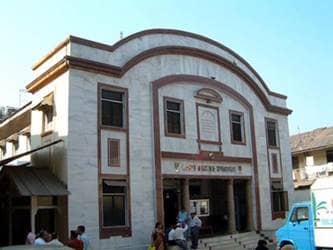
Magan Hassidam Synagogue in Bombay
This is one of the oldest synagogues in India, built around 1846 in Jacob's Circle in Bombay. It was and still is the most active synagogue, and is beautifully maintained. The Indian-Jewish community enjoys a good relationship with its neighbors--many of the synagogues are right in the midst of Muslim neighborhoods in the center of the city.Indian Jews, in spite of their small number, have played an important part in India. Families like the Sassoons and the Eliases, who were Baghdadi Jews, helped in the industrialization of the country. Noted Bene Israel Jews include Dr. E. Moses, the first mayor of Bombay in 1939, and Dr. Jerusha Jhirad, who started the Reform Jewish Movement in India.
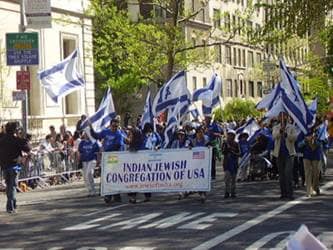
Indian Jews at the Israel Day Parade
Indian-American Jews proudly participate in the annual Israel Day Parade in New York, marching with the rest of the Jewish community along Fifth Avenue.Many Indian Jews have migrated to North America for economic opportunities, and today there are about 1500 in Canada and 350 in the U.S. It's a small but vibrant community, one that observes all the High Holidays and festivals.
The Indian Jews are scattered in all five boroughs of New York City and in New Jersey, so they attend services at non-Indian synagogues. While the liturgy is the same, the trope or musical notations in Indian-Jewish traditions are unique.
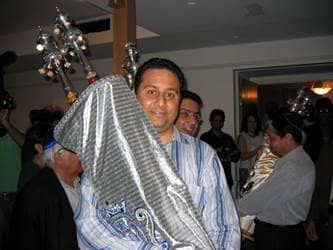
Staying Connected to India
The Indian Jews retain their ties with India. When the Beth El Synagogue in Panvel, which is 25 miles from Bombay, was deluged with heavy rains, all six Sifrei Torahs were destroyed. The Bene Israel Jews of New York came to the rescue and gave two Sifrei Torahs to this synagogue. These were personally delivered to the Indian-Jewish congregation in Panvel, and installed with joy, pomp, and a showering of rose petals.The Indian Jews in New York have fond memories of growing up in India, of close-knit communities, and freedom to practice their faith. The lure of Israel as well as economic opportunities abroad have pushed many to leave the homeland where they were born, but the connection to India remains deep.
As the Jewish population in India dwindles, the beautiful old synagogues and Jewish schools there stand as a testament to the warm welcome received by Indian Jews and a nostalgic memory for those who have now left her shores.



Tidak ada komentar:
Posting Komentar